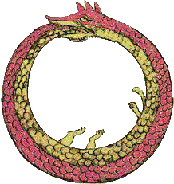Analysis of Symbols
Ouroboros (the serpent that swallows its tail) is the antique symbol of Totality seen as self-sufficient, the
all-encompassing, as self-created, the monad etc. |
The symbol analysis is a basic component of Jung's analytical method. He devoted this subject a great number
of works among which the Psychology and Alchemy.(1)Symbols often appear in dreams and this is why they request the analyst's contribution to their decrypting.(2)
Unlike Freud, who reduces almost all oneiric symbols to sexuality, Jung claims that the symbols are indications of the
archetypes and especially of the Self.(3)
Here's an example of the square symbol analysis applied to a dream:
Many people are present. They are all walking to the left around a square. The dreamer is not in the centre but to one side. They say that a gibbon is to be reconstructed.
Here the square appears for the first time. Presumably it arises from the circle with the help of
the four people. (This will be confirmed later.) Like the lapis, the tinctura rubea, and the aurum philosophicum
, the squaring of the circle was a problem that greatly exercised medieval minds. It is a symbol of the opus alchymicum, since it breaks down the original chaotic unity into the four
elements and then combines them again in a higher unity. Unity is represented by a circle and the four elements by a square. The production of one from four is the result of a process of distillation and
sublimation which takes the so-called "circular" form: the distillate is subjected to sundry distillations so that the "soul" or "spirit" shall be
extracted in its purest state. The product is generally called the "quintessence", though this is by no means the only name for the ever-hoped-for and never-to-be-discovered "One." It has, as the
alchemists say, a "thousand names," like the prima materia. Heinrich Khunrath has this to say about the circular distillation: "Through Circumrotation or a
Circular Philosophical revolving of the Quaternarius, it is brought back to the highest and purest Simplicity of the plusquamperfect Catholic Monad... Out of the gross and impure One there
cometh an exceeding pure and subtile One", and so forth. Soul and spirit must be separated from the body, and this is equivalent to death: "Therefore Paul of Tarsus saith, Cupio dissolvi, et esse cum
Christo. Therefore, my dear Philosopher, must thou catch the Spirit and Soul of the Magnesia". The spirit (or spirit and soul) is the ternarius or number three which must first be separated from its body
and, after the purification of the latter, infused back into it. Evidently the body is the fourth. Hence Khunrath refers to a passage from Pseudo-Aristotle, where the circle re-emerges from a triangle set in a
square... (From Psychology and Alchemy, Princeton University Press, p. 124-125).
Notes:
1. This is a must-read and may be purchased from Amazon.com: .http://amzn.to/2jRip1V 2. Jung introduced the amplification method when dealing
with dreams and missing the free associations of the dreamer. 3. A valuable paper dealing with Jung's and Freud's specific
approach of symbols and symbolism may be found in our paperstore here.
More Resources
--
Image source: http://www.stephenlinsteadtstudio.com/articles/ouroboros.html. <<< Back to Psychotherapy |
Home |
